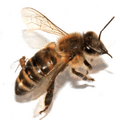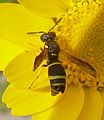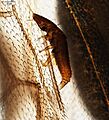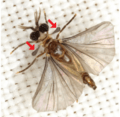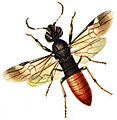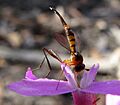Parasitoid facts for kids
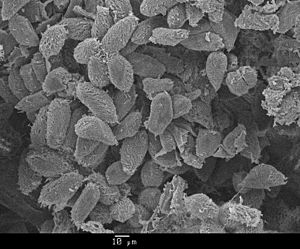
Parasitoids are a special kind of parasite. Their young, called larvae, grow inside another living thing, which is called the host. Unlike regular parasites, parasitoids usually kill their host. This is what makes them different.
Many parasitoids are wasps. There are twelve main groups of parasitic wasps that are mostly or entirely parasitoids. The largest group is the ichneumon wasps, with over 80,000 different species!
Adult parasitoids live freely. Their job is to find a host for their babies. The mother lays her eggs on or inside the host's body. The host then provides food for the growing young.
Contents
Parasitoid Wasps in Britain
In Britain, there are about 6,500 species of Hymenoptera (which includes wasps, bees, and ants). This is more than any other insect group! Nearly half of these are parasitoid wasps from just one group called Ichneumonoidea.
This group has two main families:
- Ichneumonidae: Over 2,000 species in Britain. This is the largest family of British insects.
- Braconidae: Nearly 1,200 species in Britain. This is the second largest family.
Some of the biggest parasitoids are also found in the Ichneumonoidea group.
Unique Life Cycles
Hymenopteran parasitoids often have very unusual life cycles. For example, in a family called Trigonalidae, the female wasp lays her eggs in tiny cuts she makes on the edge of leaves.
If a caterpillar eats these leaves, it might swallow some of the eggs. When the eggs reach the caterpillar's gut, they hatch. The tiny larvae then burrow through the gut wall and into the caterpillar's body. Inside, they look for other parasitoid larvae to attack and eat.
Some trigonalid wasps need their host caterpillar to be caught by a social wasp. The social wasp takes the caterpillar back to its nest to feed its own young. The trigonalid eggs, still inside the caterpillar, then hatch and use the social wasp's young as their new host!
Other Parasitoid Insects
About 10% of all known insect species are parasitoids. While most are wasps (Hymenoptera), you can also find them in other insect groups like:
- Flies (Diptera)
- Beetles (Coleoptera)
- Neuroptera (net-winged insects)
- Lepidoptera (butterflies and moths)
- Strepsiptera (twisted-wing parasites)
- Trichoptera (caddis flies)
Most of the non-wasp parasitoids are flies.
Images for kids
-
A parasitoid wasp laying eggs into a spotted alfalfa aphid. This behavior is used to control pests.
-
A hyperparasitoid wasp on the cocoons of another wasp. This second wasp was itself a parasitoid of a moth or butterfly.
-
A female phorid fly laying eggs into a honey bee. This can change the bee's behavior.
-
The head of a female strepsipteran sticking out from its wasp host's body.
-
Encarsia formosa, a tiny wasp used to control whiteflies in greenhouses.
-
Parasitic wasps with their garden tiger moth host, painted by Maria Sibylla Merian.
-
The parasitoid wasp Megarhyssa macrurus laying eggs into wood. Her body is about 5 cm long, and her egg-laying tube is about 10 cm long.
See also
 In Spanish: Parasitoide para niños
In Spanish: Parasitoide para niños





